There were/are so many nice razors out there.. no one knows them all.
Phil (of BullGoose) made the Evolution as a modern recreation of the original pre-war Darwin. I find it to be a lovely little shaver, if a bit on the aggressive side of things.
Phil of BullGoose made the Evolution as a recreation of the original pre-war Darwin. I find it to be a lovely shaver.
New week means next razor in my rotation.

- Razor: Asylum Shave Works Evolution
- Blade: Treet Platinum
- Brush: Artesania Romera Manchurian Badger, imitation horn
- Pre-Shave: Proraso Pre Shave Cream
- Lather: Pereira Shavery Shaving Cream w/ Activated Charcoal
- Aftershave: Barber No3 Marmara
- Additional Care: Alum Block
Patent time: All in One shaving mug
Shaving requires a lot of gear – at least if you want to do it the right way. You will need a brush, a mug, a mirror, and maybe even a styptic pencil. And all that stuff makes a mess on the vanity… unless you got one of the patented all in one shaving mugs invented by Bernard Goodfellow Savage and Albert Cecil Lawless Loughran, that is.
Granted, their stated goal is a little less ambitious. To quote from the patent:
>The object of the invention is to provide shaving-mug with a mirror which will virtually constitute an auxiliary bottom for the I5 mug when the mirror is not in use, the attachment between the mirror and mug being such that when the mirror is removed the mug will be completely closed at its bottom and will have a suitable base upon which to stand.
So all they wanted was a way to attach a mirror to a shaving mug – or any other mug. Although… I am less sure if my coffee mug needs a mirror?
The all in one shaving mug is well described in the patent as well as in the accompanying drawing.
The patent drawing for US patent 573,240.
Working our way from the bottom and up, we first have a small round mirror in a frame. The frame is threaded and screws onto the bottom of the mug. It also have a small, folding stand on the bottom, so you wouldn’t have to prop the mirror against something while shaving.
The mug itself is looking fairly normal. Apart from the screw threads on the bottom and top, that is. Judging by the drawing, it is right-sized to hold a puck of soap. Because unlike many modern wetshavers, our forefathers only had one shaving soap and they kept it in their shaving mug.
A cover can be screwed into the upper threads. In the cover there is a hole – also threaded – which you can screw a shaving brush into. Although the patent points out that having the brush being a friction fit works better.
In the handle of the brush there is a hollow space, normally closed by a plug. The plug, the patent states, can hold a stick of cosmetics or like material. TO my mind, the obvious choice would be a styptic pencil.
All in all the all in one shaving mug should be, in the words of the patent, a
>(…) mug or cup is of exceedingly simple, durable, and economic construction, and is capable of being packed in a convenient and safe manner, the contents of the cup and the brush at that time being thoroughly protected. The mirror in no manner interferes with the design or the usefulness of the cup or mug, and the brush may be conveniently and expeditiously disconnected from the cover and the cover from the body of the mug or cup when the latter is to be used.
I see two problems with the invention, one of which can be worked around, and the others the inventors probably saw too.
The first problem is that unless you let the brush and soap dry, you would be sealing in the water when you closed up the all in one mug. The solution is, unsurprisingly, to let things dry before packing up.
The second would be the try to get the knot trough a narrow threaded hole without badly messing up the bristles. I suspect this is why the inventors suggested using a friction fit instead of threads.
Apart from those two issues, I see no trouble with the invention as such. The all in one shaving mug keeps most of your shave gear in one spot – and I am sure a hole through the handle could be arranged to hold your razor too. For someone with just one soap and one brush, and not a large bathroom, this could be a workable solution today – just as it was a hundred and twenty eight years ago.
You can read the full patent for the all in one shaving mug at Google Patents.
Patent time: The Rally dry shaver
A little while back – because four years is nothing – I wrote a little piece on the Rally dry shaver. And now, while aimlessly poking through online patent texts, I found the patent for it.
Filed in the US and Germany by a Swede, the Rally was, as I mentioned, a lawnmower for your face. A handy way to get rid of that five o’clock shadow. A great gift that would likely be used twice and then put in a drawer.
So what was Jonas Åke Gregorius Malmberg trying to achieve? Well, mostly to improve on improving rolling drum dryshavers, apparently. By making the blades replaceable. Which makes a lot of sense, when you think about it. To quote the patent:
>The present invention relates to an improvement in such shaving-apparatus having a finely slitted rotatably mounted drum and a fixed knife applied inside and in the longitudinal direction of the said drum, and the object of the invention is to obtain an effective operating and durable shaving apparatus of this type, the invention being chiefly characterized by an open-ended casing provided with a longitudinal slot and arranged inside the drum for the purpose of guiding the same and connected with a handle, the one of the longitudinal edges of the slot in the casing being provided with a longitudinal groove for inserting an exchangeable knife, and movable locking means which in the locking position cooperate with the ends of the knife in order to keep the knife fixed in the longitudinal direction and also crosswise. This arrangement thus renders it possible to use exchangeable knives which, after being inserted in the groove in the one edge of the slotted casing is firmly locked by the locking means.
The way the Ralley works can be worked out from the text and drawings.
Patent drawings for US patent 2,637,902 (and German patent 830,305)
The user would roll the finely slotted drum over his stubble. The stubble would – hopefully – enter the thin slots. The movement of the drum would bring the stubble to the blade, which would – hopefully – cut it.
One end of the Rally could swing up to access the interior of the drum. This both allowed the interior to be cleaned, and the blade to be replaced. The folding drum covers acted as the handle, as can be seen in the photo in my previous post. And the whole thing could fit in a pocket.
I can see a couple of ways to improve the Rally roller razor. The most obvious one would be a second blade. By mirroring the placement in the drum, the user would be able to roll it both ways. As Jonas drew and – likely – manufactured the Rally, it would only cut when rolled in one direction.
If it would cut much at all, that is. After all, the idea is that your stubble should somehow enter the slots – and not slip out again. So if your stubble is too stiff, or too thick, or too bendy, or too thin… the Rally would work less good.
You can read the full patent text for the Rally rolling razor over at Google Patents.
Patent time: Attachable and Detachable Back for Razor-Blades
A problem challenge with straight razors is that they require skill to keep sharp. A safety razor on the other hand – be it using double edged, single edged, or even wedge blades – requires a lot less skill. So it is perhaps inevitable that someone will come up with a straight that uses replacable blades. Today we often call them shavettes. But when A V Brokhahne and C Langbein patented an early version back in 1887, they choose a more descriptive name: attachable and detachable back for razor-blades.
Conceptually there is little – if anything – that conceptually differs between their attachable and detachable back and a modern shavette.
There is a holder for the blade. The holder can be swung to rest against a handle. The whole thing looks more or less like a straight. The main differences seems to be the way the blade is secured, and that you would have to remove the blade to fold it.
But first, let us see how the inventors described their idea:
>Our invention relates to detachable spring-backs primarily intended for holding the blades of safety-razors—as, for example, such as that for which Letters Patent were granted to F. and O. F. Kampfe, June 15, 1880, No. 228,904; but it is also applicable to the holding of a detachable blade for razors for actual use in shaving. It consists, partly, in the combination of a detachable and attachable spring-back for holding the blade of a razor for stropping the same or for shaving with the same, and a tang attached to said spring-back and pivoted to a handle for conveniently holding the same while stropping or shaving.
And yes, the attachable and detachable back for razor-blades was patented as an third part add-on of sorts to the Kampfe razor.
The Kampfe came with a holder for holding the blade while you stropped it. A holder which almost looks like you could use as a makeshift shavette. Brokhahne and Langbein’s invention aims to replace the blade holder with one that could be used for both stropping and shaving.
Since it was meant to be used with a wedge blade, the blade holder could be a simple piece of shaped steel. The laminated handle was vide enough to fit into the slot. All in all it is of remarkable simple construction, as can be seen in the drawing.
Patent drawing for US patent 377,926
I see no reason why a modern version of this couldn’t be made to fit a GEM-blade. But if I were to make one, I would make a slot in the handle for the blade, so it could stay in the attachable and detachable back.
You can read the full patent for the Attachable and Detachable Back for Razor-Blades over at Google Patents.
History time: The Big Fellow
The Big Fellow.
A new – in 1920 – Old Type. Even if no one called it an Old Type back then, because the New Type wasn’t even a twinkle in Gillette’s eye.
So what is a Big Fellow, and how did I learn about it? Especially seeing as how I’ve not heard the term before, at least not used on a razor?
Well, to tackle the last question first; I learned about it because I found an advertisement that appeared in the Literary Digest in 1920.
This advertisement, in fact:
1920 advertisement for the Big Fellow
In short, it is a Gillette for guys with big hands. Meaning, as far as I can understand, it has a longer handle than the other Old Types.
Realising that, I also realised another thing.
I actually do own a Big Fellow. I found it at a flea marked a little over six years ago. And after a clean-up, it has stayed in my rotation ever since. I misidentified it at the time, but comparing it to the drawing… it’s a Big Fellow.
It’s a funny old world… I learned about an unknown-to-me subset of the Gillette Old, and it turns out I own and use one. How cool is that?
There is a 20010 paper debunking it, as I wrote about a few years ago.
Arguable Gillette are closer to a razor and blade model now than they ever was making proper safety razors.
History time: No shadow of doubt…
No shadow of doubt ever exists in the mind of a man who uses a –
Gillette Safety Razor.
Well, at least that was the claim in this 1905 advertisement for the new Gillette safety razor; the one we today would call the Old Type. Which was then the very newest type, and also the only type.
1905 advertisement from the Literary Digest.
In 1905 you would be an early adopter, and like most early adopters you would pay for the privilege. While the ad don’t mention how much you would have to fork over for an ideal holiday gift (either the standard silver-plate or the gold plated special set), they do mention how much you would have to pay for a dozen new blades.
One dollar.
Which may not sound like much for a claimed 240 to 480 shaves, but… inflation can be harsh. One dollar in 1905 is roughly the same as 36 dollars today (33€, 28£, or 395 Norwegian kroner). So not cheap.
But at least there would be no shadow of doubt in the mind of the shaver. But today I would very much doubt the mind of a man who opts to use the latest Gillette cartridge razor, at least if he has had the option of trying a proper safety razor.
As a side note, I like that they point out out their patent (#775,134) and what they claim it covers.
Patent time: Shaving brush with interchangeable bristles
I have pointed it out before. Perfection is not achieved when there is nothing more to add – but rather when there is nothing more to remove. Seen through that lens, John B Lydiards 2020 patent for a shaving brush with interchangeable bristles is far from perfect.
The idea is simple enough. Different shaving brush knots have different qualities, and people prefer different knots. Some likes the softness of badger, some prefer a scritchy boar. Me, I like a good horse. But to get back on track, let us see what John had to say in the patent text
>A problem with shaving brushes is that the bristles are permanently attached by glue or other adhesive, thus making it impossible to change to different bristles according to the desires of the user, thereby requiring one to purchase multiple brushes for different bristles. Thus, a need exists for a shaving brush which will allow a user to change to different types of bristles, such as without limitation, synthetic, boar, badger, or bristle knot, by cartridgizing the shaving brush knot.
Needlessly to say, I disagree with the perceived need. And I have a reasonable modest brush collection, compared to some shavers.
So, how were John planning to get around using an adhesive to secure the knot in the handle? By replacing it with arrangement of threads, levers, push-rods, bell-cranks and a clamp. Easy-peasy.
The pictures do more justice to the gadgetry of the invention than mere words.
From my understanding of how John envisioned his shaving brush with interchangeable bristles working, this would be the order of operations:
- Loosen the tension ring (#1 on the drawing) and screw it all the way down.
- Push on the spring loaded release button (#4) so the two halves of the fastening cuffs (#9) swings up and to the side.
- Pick up the old knot (#32) from the floor, sink, or wherever it fell.
- Insert a new knot (still #32) with an adaption hoop (#12) into the fastening cuffs (#9) and push the cuffs together.
- Screw the tension ring (#1) all the way up around the fastening cuff (#9) and tighten it.
Now, compare this to how I pick a new shaving brush knot:
- Reach out, grasp the brush I want.
And even if it wasn’t pointlessly complicated, John seems to have forgotten one minor thing: Storing a shaving brush knot takes up about as much space as storing a whole shaving brush! So there is added complexity with no benefit that I can see.
I mean, I can see part of what he was going for. The words cartridgizing the shaving brush knot gives the game away. I think John wanted to set up a walled garden, where people who bought his handle would have to turn to him for shaving knots.
While it is only two years since John patented his brush with interchangeable bristles, I just can not see it being successful in the marked – unless the target audience is people with more money than common sense.
Which is, admittedly, a large market.
You can read the full patent for the shaving brush with interchangeable bristles over at Google Patents.
Late to the game (just had my father in law visit for three weeks, so...) but if you want my take;
Injectors are fun. You can only get a couple of different blades (Schick, twin Schick, and Personna) for them, but the injectors I own (five, so far) definitely have earned their keep in my rotation.
Compared to other razors, injectors are - in my experience - more consistent between models. A Type E shaves much like a Type G etc. Other razors - especially double edged razors, have a much greater variety both in the razors and the blades (and feathers are not the best of the bunch, in my not at all humble opinion).
So if you want to experiment, branch out into double edged. Pick up a vintage Gillette Old or Tech, and go from there :)
Patent time: A brush with a notch, with soap cup and lathering bowl
One would thing there would be little left to invent, at least as far as shaving brushes goes. One would be wrong. Over in Japan, Mrs 由美子 井上 – or Yumiko Inoue for those of us who don’t read Japanese – recently got a patent for a shaving brush with a notch.
We have looked at a lot of brushes before. And I do mean a lot; folding, telescoping, collapsible, self-feeding, fountain style, antiseptic, disposable, self destructing, hygienic, sanitary, and many, many more. But Yumiko’s idea is the first notched brush that I can recall seeing.
Yet the idea is delightfully useful. The notch will let you rest the brush on the edge of a shelf (if the shelf has a lip of a certain size, that is). Or, perhaps more interesting, the notch lets the brush rest on the lid of a box. A box that is also a combined soap holder and ‘roughing bowl’. Or, as I would put it, a lather bowl.
The notch is sized so the brush can also rest on the size of the lather bowl.
And while the patent uses a lot of words to describe the brush with a notch, as well as the nesting bowls, the claims summarise it nicely:
>A brush characterized by having a recess or a notch that fits into a locked body at the center of the handle in the longitudinal direction.
>When the locked body is one or more of the handles provided on the protrusion, the protrusion, the edge of the container, and the lid, and the recess or the notch is fitted into the locked body, the handle is fitted. The brush according to claim 1, wherein the brush is held horizontally or with the hair bundle facing diagonally downward.
>A whisk comprising the brush according to claim 1 or 2, and a whisk container for whipping a cleaning agent or soap.
>The whipping container includes a razoring bowl for whipping shaving soap, a soap dish on which the shaving soap can be stored, and a removable cover having a handle on the upper surface, which covers the soap dish. The whipping device according to claim 3, further comprising, the recess or the notch being fitted into the handle of the cover or the edge of the roughing bowl, and the brush can be held.
I know, auto-translate makes somewhat of a dogs breakfast out of the text. But luckily the drawings are very clear.
I find myself almost wanting Yumiko’s brush with notch – and the nested soap-cup and lathering bowl too. It would make an excellent addition to my shave gear. Perhaps as my at work shave set.
You can read the whole translated patent at Google Patents, or over at Espacenet.
Patent time: The Simens Razor Sharpener Patent
A couple of days ago I shared a video I found on the restoration of a Simens razor sharpener. And guess what? I’ve now found the patent for it. Filed by Ferdinand Souczeck in 1933, the patent was applied for in – as far as I can tell – Czechoslovakia, Austria, and USA.
I’m not sure if Ferdinand worked for Simens, of if they simply bought the rights of him. What I do know is that Simens must have manufactured the device in several places. The one I own is clearly marked as made in Sweden, while other examples I found online is marked with Austria, Japan, USA, USSR, and elsewhere.
Every invention is an attempt to solve a problem. But the problem Ferdinand tried to solve wasn’t to sharpen the blade per se – it was to sharpen it better. To quote:
>In known grinding devices of this type, the movement between the razor blade and the grinding agent which is necessary for the grinding is generally only rectilinear and of a definite type of stroke, regardless of whether it is parallel, inclined or perpendicular to the edge and whether a grindstone or grinding rolls are used. However, this type of grinding favors the production on the sides of the edge of the blade of grooves which make it difficult or even impossible to obtain a complete grinding of the sides of the edge. The grinding, moreover, results in subjecting the blades to an injurious bending stress.
So according to Ferdinand, the problem with other razor blade sharpeners were that they were grinding in a linear back and forth motion. The solution, he claimed, would be to move the blade in a circular motion. And while other sharpeners did that, Ferdinand claimed they put a bending motion on the blade.
The solution Ferdinand came up with, and Simens manufactured, was a box with a string. You put your blade in the box, closed the lid, and pulled the string. And when you opened the box, your blade was sharper.
Patent drawing for US patent 2,004,838
Inside the box is where the magic happened. As can be seen from the drawings, there are a few things going on.
In one half of the box you have three gear wheels with pulleys. The two outermost ones have eccentric spindles. The string is wrapped around the pulleys.
On either side of these gearwheels are two spring loaded grinding members, set at an angle. A matching set of two grinding members are set in the opposite lid as well.
As can be seen, the blade is placed on the spindles. Once the box is closed, the grinding elements are pressed against the blade sides. And when the string is pulled, it rotates the gears, which in turn moves the blade in a circle.
Or as Ferdinand put it in the patent text:
>When the razor blade is positioned on the carrier pins 18 and the device is closed, the blade prevents the inter-engagement of opposing grinding teeth and, under the opposite but equal spring forces constituting the grinding pressure, is accurately positioned centrally of the gap formed between the two halves of the casing by the collars on the guide pins I I when the grinding members on both sides are not overlapped by the razor blade to the same extent (see Figure 2).
>If now the somewhat tensioned operating cord 11 is pulled from side to side, or, in the case where the cord is stationary, the grinding device itself is reciprocated along the cord, the razor blade will execute a curvilinear movement in its own plane.
There is, of course, a few differences between the device as patented, and the device as built. The big one is in the shape and position of the grinding members. Whereas the patent shows them with a flat top and set at an angle, my Simens sharpener (and every other one I’ve seen pictures of) has them with an angled top and set straight in the box.
Unlike so many of the patents I discuss, this one was quite successful. If you search for “razor blade sharpener” online today, a lot of your results will be of the Simens razor blade sharpener. It was successful enough that an Albert B Swanson filed a patent for what was basically an electric version of it in 1958.
Today, we are often told, you shouldn’t sharpen a regular razor blade. But if you needed to, a Simens razor blade sharpener would be just the thing to do it with.
You can read the full patent for Simens razor blade sharpener on Google Patents.
Patent time: Griffbefestigung an Rasierapparaten – handle attachment to shaving apparatus
It is easy to forget, as one is looking at old patents online, that not every inventor spoke English. I’ve looked at several interesting non-english patents in the past, and stumbled over an interesting looking one today too. It is for how to do attach a handle to your shaving apparatus. Or to put it in a different way; a handle attachment to your razor.
Patented by Paul Druseidt, the invention gives a razor that both pack flat and is easy to assemble. It consists of a normal-ish razor head and a U-shaped handle made from spring steel. The handle is ever so slightly smaller than the head of the razor and can nestle inside it.
Patent drawing from German patent 323,451
The key is the shape of the recesses or hole on the underside of the razor. The keyhole, if you will. As can be seen from the drawing, it was longer one way than the other, and had arches or troughs on either side.
The U-shaped handle was, as mentioned, springy. You would insert it along the long axis of the hole, then twist it 90°. The arches on either side would stop it from slipping back, and the tension of the spring steel would hold it in place. After shaving the handle could be twisted back, removed, and placed against the inside of the razor head
Or, to quote the patent;
>…der U-förmig gebogene Handgriff 6 zwecks Befestigung an der Kammplatte 2 mit seinen federnden Enden 5 in zwei unter der Kammplatte vorgesehene muldenförmige Aussparungen 4 eingeführt und sodann um 90° gedreht wird, wobei die federnden Enden in zwei weitere, enger aneinander liegende, muldenförmige Aussparungen 3 eintreten und in diesen festgehalten werden, während er nach Gebrauch aus den muldenförmigen Aussparungen herausgezogen und von unten gegen die Kammplatte gelegt wird.
For those whose German is a bit rusty, the autotranslated version runs as follows:
>…the U-shaped curved handle 6 for attachment to the comb plate 2 with its resilient Ends 5 inserted into two trough-shaped recesses 4 provided under the comb plate and then rotated by 90 °, the resilient ends in two more, narrower Adjacent, trough-shaped recesses 3 enter and held in these while he is pulled out of the trough-shaped recesses after use and is placed against the comb plate from below.
All clear and fairly straight forward.
I though initially that a top cap could have been fastened by the pair of hook shaped projections on the bottom plate. I also though that these projections also would have acted as blade guides for a normal Gillette three hole blade.
Further research showed me that maybe was no top cap, and the hooks just held on to a proprietary blade. The first hint came in Waits’ Razor Compendium. Waits’ Compendium do mention a Druseidt razor – along with the similar Impero and Ratio razor. And in the description of the later, Waits states that “the special thick double-edged blade has two square holes and two centre oval dimples”.
Waits’ Compendium also mentions that “later versions has two pieces”, by which he seems to mean that at least the late production Ratio was made with a top cap. This in turn matches with pictures I found in a thread over on Shaving Universe, which clearly shows a top cap.
A top cap, I might add, that looks very much like Waits’ description of a “special thick double edged blade”…
Was Waits just confusing a poor quality picture of a top cap for a proprietary blade? Quite possible. It could simply be that a lot of the Druseidt, Impero, and Ratio razors that have survived have lost their top caps over the years.
Interestingly all three of the razors mentioned also have u-shaped handles. But none of the three has the handle attachment method described in the patent. Instead they uses a swinging out handle, which still relies on spring pressure to lock in place.
Overall the Druseidt patent looks like it would make an interesting razor, possible more interesting than the Druseidt razors that were actually manufactured.
You can read the full text of Druseidt’s patent at Espacenet, or a translated version at Google Patents.
Patent time: Aloe’s Folding Razor
A razor can take up space in a gentleman’s vest-pocket… a problem several inventors searched for a solution to, including Mr Albert S Aloe. He came up with a folding razor all the way back in 1886.
Described, unsurprisingly, as a new and useful improvement in safety razors, Albert didn’t have the benefit of the thin replaceable blade. Like most razors of this era he had to work with a wedge blade. A wedge blade is chunkier than a modern razor blade, but also has the benefit that it can be stropped and honed.
In hindsight his razor is simple enough. A couple of pieces of sheet metal, shaped to hold and clamp a razor blade. The blade holder and guard were made to fold flat when not in use. In some ways you could see it as a folding version of John Monks’ razor.
Patent drawing for US patent 375,592
It is worth noting that the first claim in the patent isn’t the razor per se. Rather it is for the spiral guard, which was meant to ‘carry the lather endwise’ when the razor was used. Or in simpler words; keep the lather out of the way.
The blade was held in place by a spring loaded catch. This also made sure the distance between the edge and the guard stayed constant, even as the edge was gently worn away by stropping and honing. You could say the blade was self adjusting to keep it working as intended.
I see no reason why Aloe’s folding razor shouldn’t work as intended, nor any reason why a version couldn’t be made for a GEM blade. At the same time I see no reason why anyone would want one today, as it is unergonomic and looks like a kludge.
You can read the full patent for Aloe’s folding razor at Google Patents.
Christy blade comparison – aka “where can I get a Christy blade today?”
I little while ago I bought a Christy razor. It’s a fun and interesting razor, fairly unique compared to modern razor. And, as I mentioned, you can’t get blades any more, as the Christy blade (which existed in a couple of variations) went out of production sometime in the late 30’s.
Some of you wondered if I couldn’t get another blade to fit.. and the answer; no, not really. And this is why:
First off, apologies for the glare in some of these pictures – taking photos of shiny blades can be difficult.
From the top: Common DE, GEM, Injector, and Christy blades.
No other blades are a good match – or even a partial match, for the Christy. It’s not just a matter of width and thickness, but more importantly of the inclined blade alignment cut-outs on the sides of the Christy.
The Christy compared to a common double edged blade.
You could trim a DE to match part of the outline of the Christy. However the slot means you can’t replicate the top part of the alignment cut-outs. And the cut-outs are also the blade stops, so there would be nothing keeping the blade in place. Nor would anything stop it from sliding too far forward.
The Christy compared to a GEM blade.
The GEM is the best candidate for conversion. But you’ll have to despine it, trim some of the top, do some very careful trimming of the length, and nibble a little for the shape of the alignment cut-outs. And even so the alignment won’t work, as the cut-outs on the GEM are too deep.
The Christy comparted to an injector blade
The injector blade seems to be a no-go from the start. Yes, you could trim a little to match the bottom of the alignment cut-outs, since the length is a good fit. But since the cut-outs are also the blade stops, you’ll have the same problems as you would with a DE.
So the question still remains; Where can I get a Christy blade today? I have this interesting old razor, and I can’t shave with it.
Razor: Autostrop VC2 Blade: Feather FHS-10 Brush: Vie-Long #14033 Pre-Shave: Proraso Pre Shave Cream Lather: Asylum Shave Works Frankincense & Myrrh Aftershave: Asylum Shave Works Frankincense & Myrrh Additional Care: Alum Block
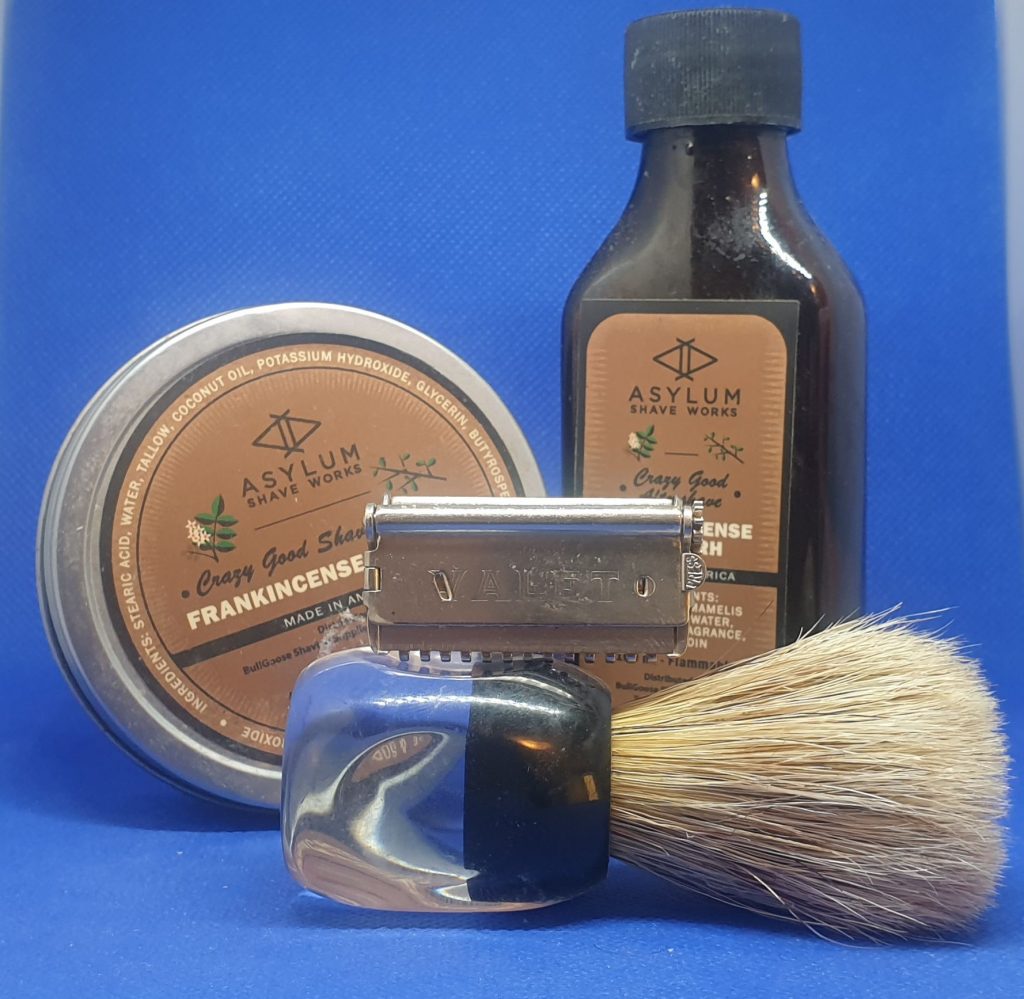
It is seventy-nine years since the end of the War in the European Theatre, and I had a wonderful Wednesday shave.
Still waffling on the strop yes. But I'm not sure how that would affect the razor, especially as I started with a fresh blade.
Shaving with the Valet Autostrop VC2 - a review of sorts
A little while ago I bought a Valet Autostrop, almost by accident.
Unlike some vintage razors, you can still get blades for the Valet. And since I consider myself a shaver and not a collector, I got some blades and gave the Valet a spin to see if it belongs in my rotation.
The jury is still out on that though. Yes, I have shaved with it for a week, but a few shaves isn’t enough to show me just how good the Valet is.
Of how bad, for that matter.
The Valet Autostrop in question
It is – mechanically speaking – a very interesting razor. The way it secures the blade is different. The way it aligns the blade is different – yet similar. And the blade itself is different too.
Then you have the whole “push lever to release blade holder so it swings freely”. It is there so you could strop the blade – hence the name Autostrop. The strop actually goes through the razor, and the blade swung in the right direction as you pulled the razor along the strop. The whole thing was highlighted in advertisements and animatronic displays.
Historically it is also an interesting razor. You could consider it an also-ran when compared to Gillette – but also compared to the GEMs and even Schick’s Injectors. It is more complicated than most other razors. The construction is mostly sheet metal. It requires it’s own blades. And yet it survived, unlike other also-rans like the Christy or the CURBO.
As mentioned, blades are still made for it – although you have a lot less choice in blades than you do for a DE or even an Injector blade. Some report using a de-spined GEM-blade in their Valets – I can see that in the early A, B, and VC1 perhaps… but in the VC2 and later you have to work around the alignment bumps. Bumps which, by the way, different between various models of the razor – but always lined up with part of the VALET name cut out in the blade.
A week of shaves with the Valet Autostrop VC2
As far as the shave goes… the Valet Autostrop VC2 is pretty middle of the road.
It is not great, but not terrible.
It don’t nip or scrape, but it is a bit on the mild side of things. Getting the angle right was a little tricky, until I realised that like my GEM razors you can simply place the top cap flat against the face. The left side blade stop has a small burr on it I probably ought to take a small file to. People tell me the FHS-10 blade dulls quickly, but I didn’t notice much degradation over the course of a week.
Will the Valet VC2 make it into my permanent rotation? How long will the blade last me? I don’t know.
I don’t know yet, that is. I’m heading into the second week of shaving with it. There might be a third.
- Razor: Autostrop VC2
- Blade: Feather FHS-10
- Brush: Wilkinson Sword Badger
- Pre-Shave: Proraso Pre Shave Cream
- Lather: GzD Shavestick
- Aftershave: Barber No3 Marmara
- Additional Care: Alum Block
Another week and another shave. The blade still keeps up, although I can tell it is not quite as smooth.
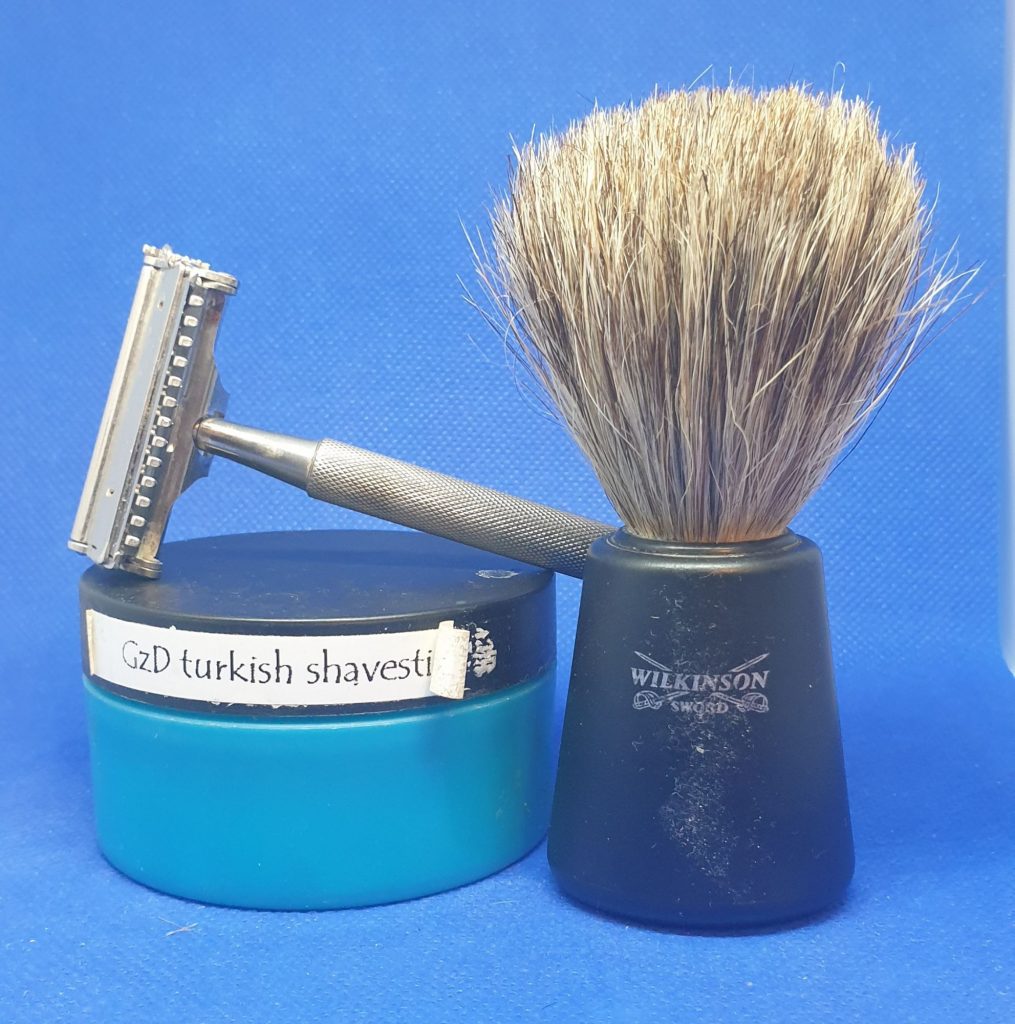
If I remember later, I can post a comparison of the blade vs other blades like the GEM and a standard DE
The other new arrival: a Christy razor
We know how it goes. Peacefully puttering around on the internet, and boom: You accidentally bought two vintage razors. Earlier this week we looked at one of them, and today we’ll have a peek at the other. The other being a Christy razor.
Christy, like the CURBO, Diamond Edge, and others, were aiming for the low end of the shaving marked. Whereas Gillette and others were offering affordable razors, Christy’s razors were cheap or even free.
The seller had mislabelled this in their classified ad; the seller had it listed as an Gillette. It came in the original box, with a couple of spare blades.
My Christy is a very neat little razor. It is sleek and lightweight, and has a couple of interesting features.
The blade has a unique shape, as can be seen in the pictures. The shape of the blade can be traced to US patent 1,563,724, filed in 1921. The rest of the razor don’t match that patent though, but rather partly matches a 1927 advertisement for the Christy with a ‘massage bar‘. Apart from lacking the massage bar, that is.
The ears and angled cut-outs on the blades matches to bumps on the bottom plate. These bumps acts as both alignment guides and blade stops. Two raised ears on the bottom plate helps guide the plate onto the top cap. The top cap has a tab that is wrapped under it, which both hold the handle and – more importantly – presses the bottom plate up against the top cap. This locks the razor together securely.
The razor also came with two spare blades, wrapped in an old Gillette blade wrapper.
My best guess is that this Christy dates from between 1921 and 1927. But that is mostly based on the patent and the advertisement, so it’s a tenuis guess at best.
While there is nothing wrong with the razor itself – at least nothing that some soap and TLC can’t fix – I’m stuck as far as blades goes. To the best of my knowledge, no one makes Christy blades no more. Nor have I had much luck finding a guide on how to modify other blades to fit.
I'm not sure yet. One step at a time and all that.
Well, at least one shave so far :P
New arrival: Valet Autostrop VC2
We’ve all been there. You are peacefully puttering around on the internet, and suddenly you’ve accidentally bought a razor. Or two, as I happened to do a couple of weeks ago. So let’s have a look at one of my latest accidental buys; a Valet Autostrop VC1. At least it was listed as a VC1 – right now I’m less certain, as the blade holder is a much closer match to the description of a Valet VC2.
From what both the internet and Waits’ Compendium tells me, the VC1 was introduced in 1922. It likely stayed in production until 1928, when the VC2 came out. The VC2 was manufactured until 1935. The VC3 replaced it, and was in turn replaced by the VC4 in 1940. Production seems to have ended in 1946.
The main difference between the VC2 and the VB2 – which was manufactured at the same time – was that the VB2 was supposed to be adjustable (according to Waits at least).
My Autostrop – whatever model it is – came in the original box. And with the original strap. But without any original blades, which I would never have used anyway.
Box has definitely seen better days, but it is a cardboard box that’s almost one hundred years old.
The strop has dried out, which is unsurprising, but looks to be in remarkable good shape otherwise. I am assuming some leather grease will soften it up if desired.
For being old, it is in quite good shape. A bit of grime, but not much in the way of plating loss.
The Autostrop has a blade holder that differs from pretty much any other razor I’ve owned. You have to swing the holder up and over – as you would if you were to strop the blade – before opening a flap. The top cap has a pair of studs, that aligns with cut-outs in the blade and flap. The blade holder is held in place by pressing the guard against it, controlled by the lever on the back of the head.
You can still buy blades that fit the Autostrop. The Feather FHS-10, to be precise. So I naturally bought some. If the razor could be shaved with, it should be shaved with – I’m a shaver, not a collector.
But that also means that a century of dust and grime had to be cleaned of…
The patent number referred to at the underside of the razor head is British Patent 184,808 by the way. The 1922 patent is the same as the US patent 1,492,246, filed in 1921 but not granted until 1924. It makes sense that the razor refers to the British patent, as they text on the underside of the blade holder flap refers to Autostrop Safety Razor Co Ltd, London, England.
Overall I’m very happy with the condition of the razor, and even happier by the fact that I can get blades for it.
- Razor: Autostrop VC2
- Blade: Feather FHS-10
- Brush: Semogue TSN LE 2012
- Pre-Shave: Proraso Pre Shave Cream
- Lather: Taylor of Old Bond Street Peppermint
- Aftershave: Barber No3 Marmara
- Additional Care: Alum Block
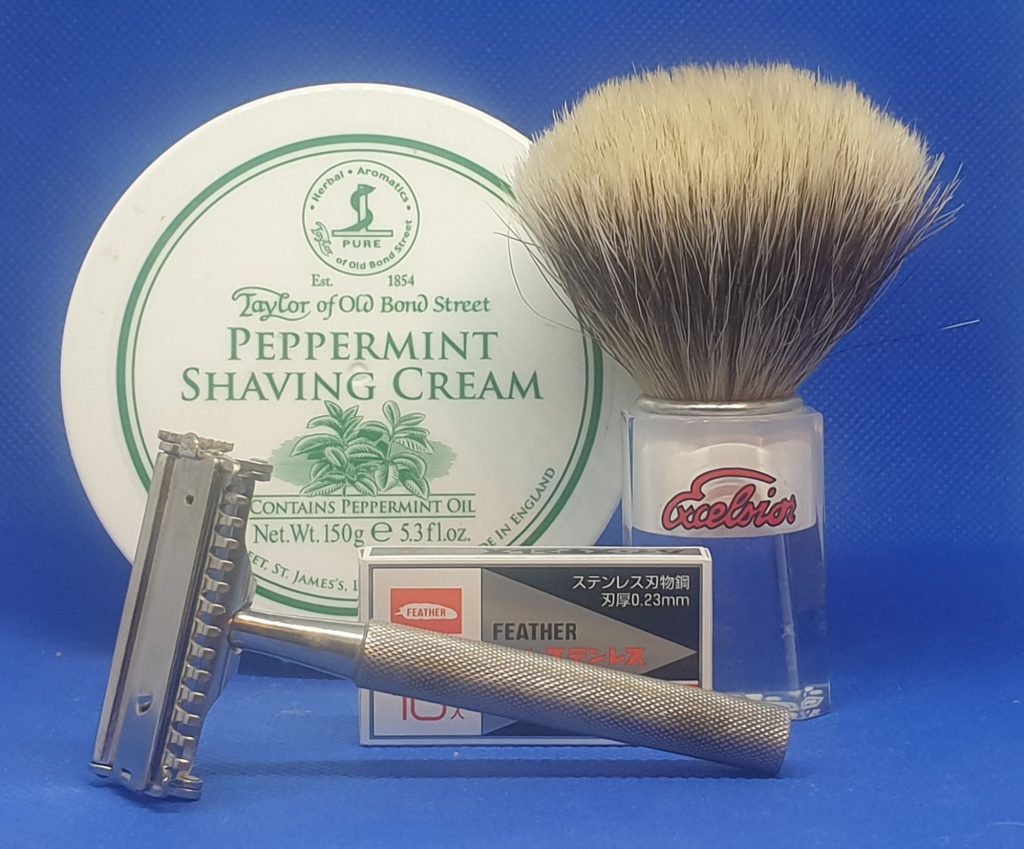
A new week. A new shave. And a new-to-me razor. And for the first time in years I actually had to think about how to insert the blade.
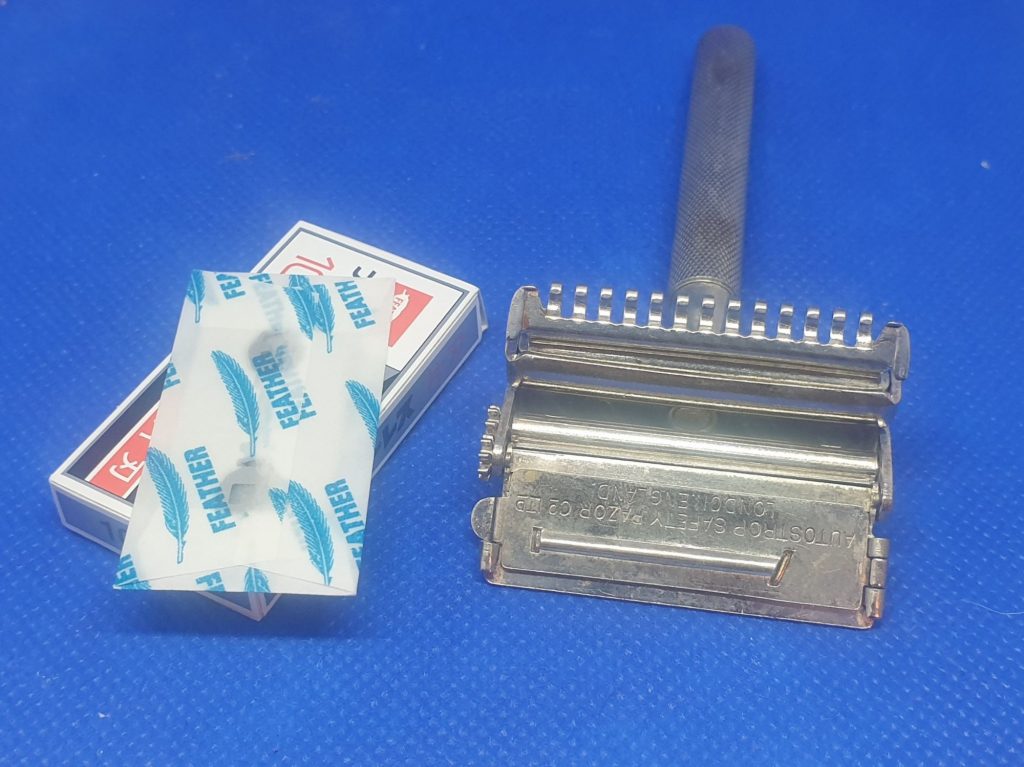
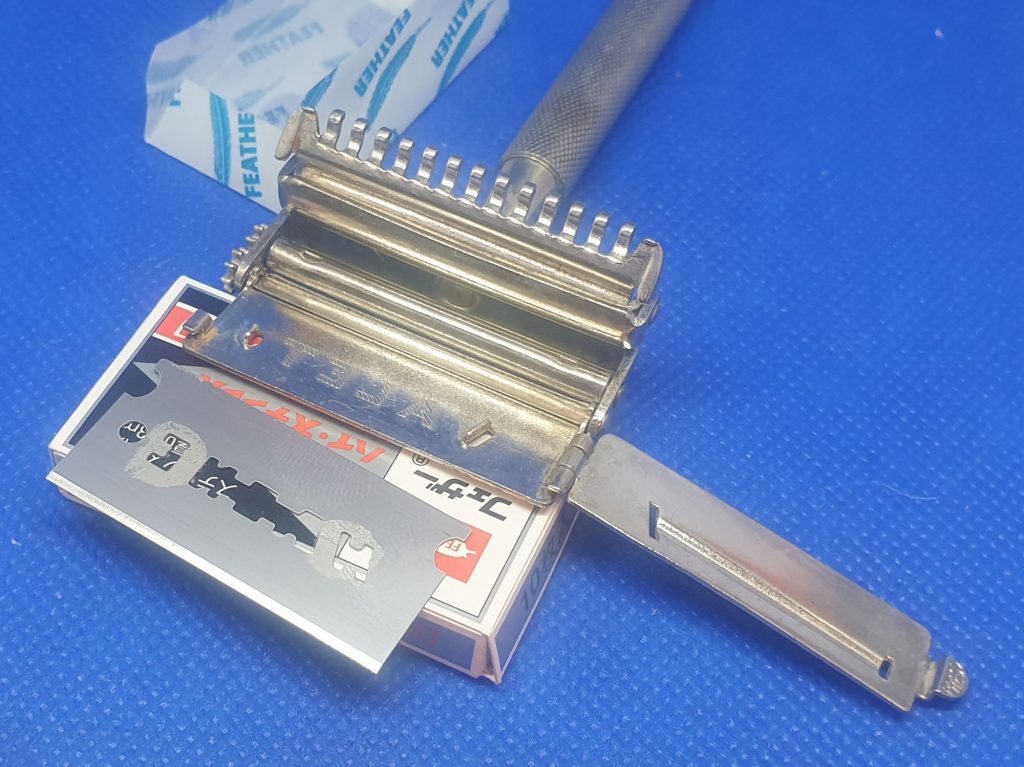
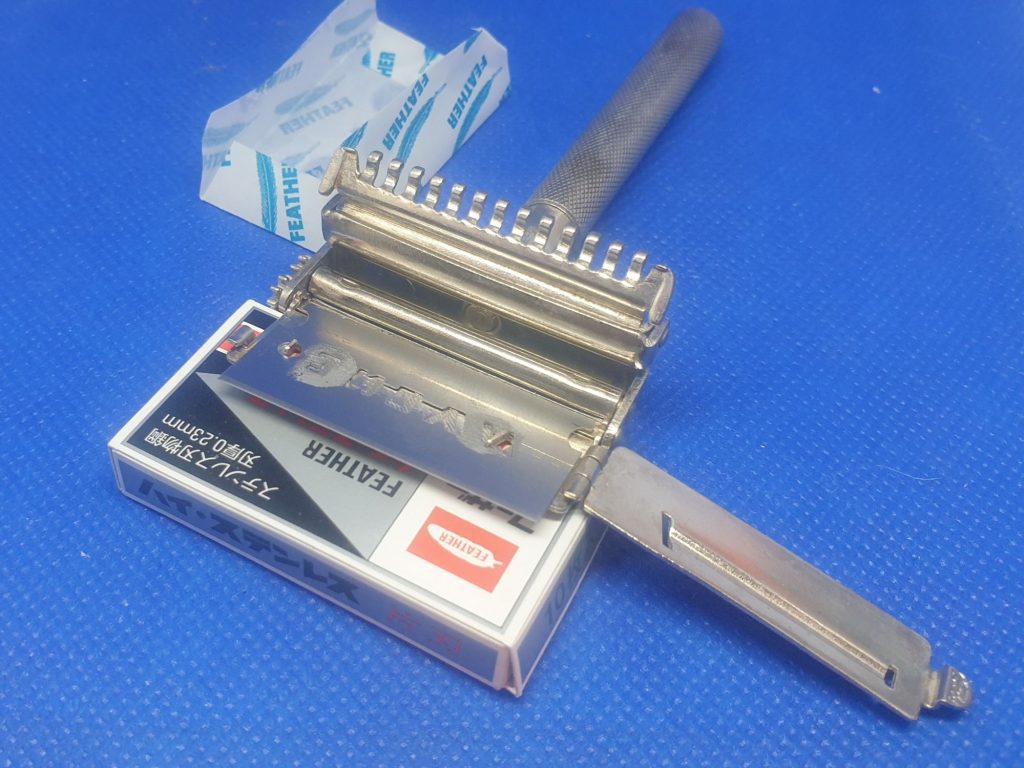
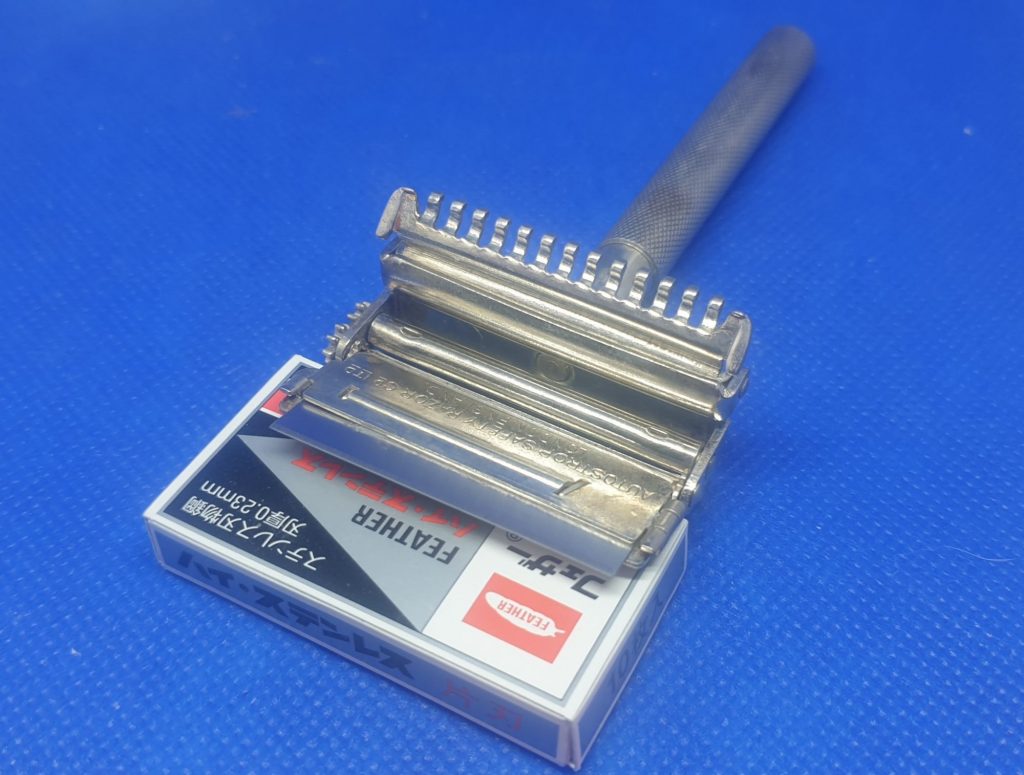
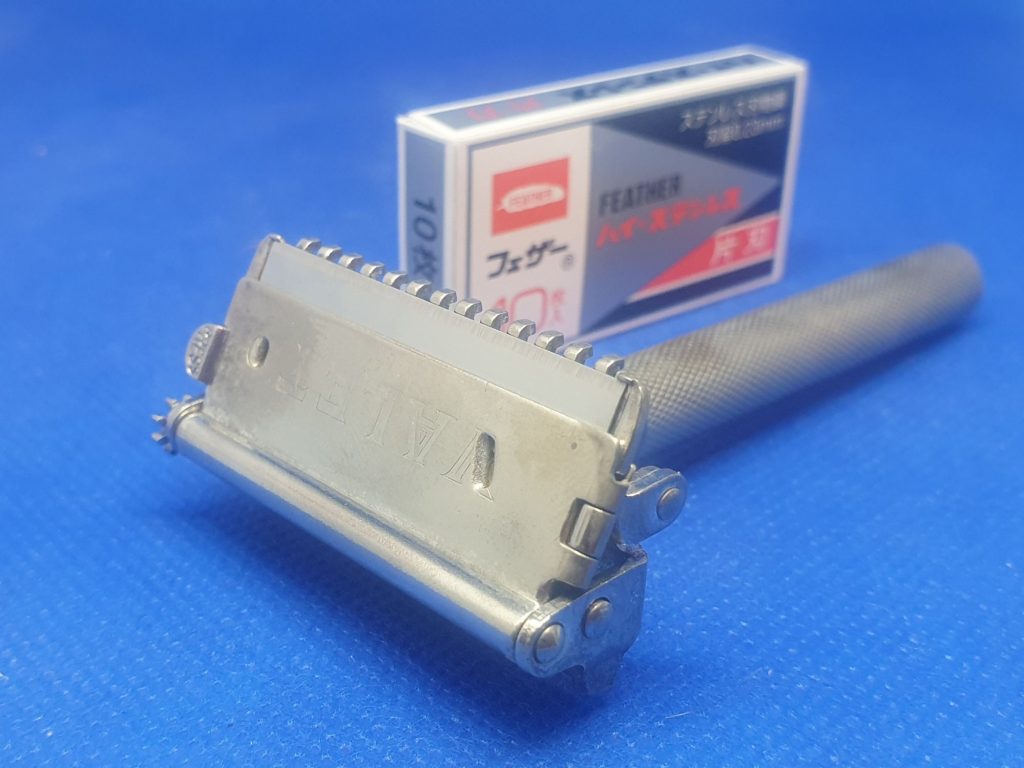
Patent time: Adapter for safety razors
Have a Double Edged razor you enjoy? Want to use your favourite GEM or other Single Edged blade? Fear not, Walter Althof1 patented the solution in 1923; An adapter that let you use a single edged blade in a double edged razor.
Well, more on than in. But even so, you could use your favourite single edged blade in on with your favourite double edged razor.
As to why you should is a completely different question. And one the patent text fails to address. What it does talk about though, is the position of your hand while shaving. To quote:
>The object of the invention is to produce a device capable of being assembled with the ordinary safety razor of the double edge blade type to adapt said razor for use with a single edge blade. Further, safety razors of the double edge blade type support the blade in a position practically at right angles to the longitudinal axis or extension of the handle so that the handle must be held at substantially right angles to the surface to be shaved. Such a position is unnatural, and somewhat difficult for the hand of the operator to assume, and another object of the invention is to produce a simple and inexpensive device, capable of assemblage with a razor of the double-edge blade type that will support a blade in a normally inclined position disposed at a substantial angle to the plane perpendicular to the longitudinal axis of the handle. Thus, a razor substantially of the character known as “hoe type” is produced.
The actual device patented is fairly straight forward. The adapter is little more than a bent piece of sheet metal.
Patent drawing for US patent 1,453,487
The adapter has a fairly complex shape, but should be easy to manufacture in a suitable press. Or it could – conceivably – be an extruded metal profile. The bottom part is concave to fit between the bottom plate and top cap of the razor. The upper part is shaped to hold the blade. A small flange (marked 16 on the drawing) presses the blade against the top cap and bottom plate.
The patent also suggests a special blade, with a groove about half way down the blade that will engage the top cap. But I can easily see using a GEM blade in the adapter, if the design is adjusted so that the flange would grip under the spine of the blade.
As designed, the adapter is suitable for razors using three posts for blade alignment. It should be possible to redesign it for other razors too, by replacing the three cut-outs with the same slot as a normal double edged razor blade has.
To use it, you would place the adapter on the razor, place the blade in the adapter, and tighten the handle. And that is about it. Just shave as normal, just remember to check the angle of attack.
I see no reason why the adapter shouldn’t work as intended. I just don’t see a compelling reason why you should use it. But even so.. if someone offered this for sale, I would probably buy one. Or two…
You can read the full patent text for the adapter to use SE Blades with DE Razors on Google Patents, as well as over on razors.click.
---
- Of the city of Geneva, in the county of Ontario, in the State of New York
- Razor: Schick E2
- Blade: Personna Injector
- Brush: Wilkinson Sword Badger
- Pre-Shave: Proraso Pre Shave Cream
- Lather: Arko Shavestick
- Aftershave: Barber No3 Marmara
- Additional Care: Alum Block
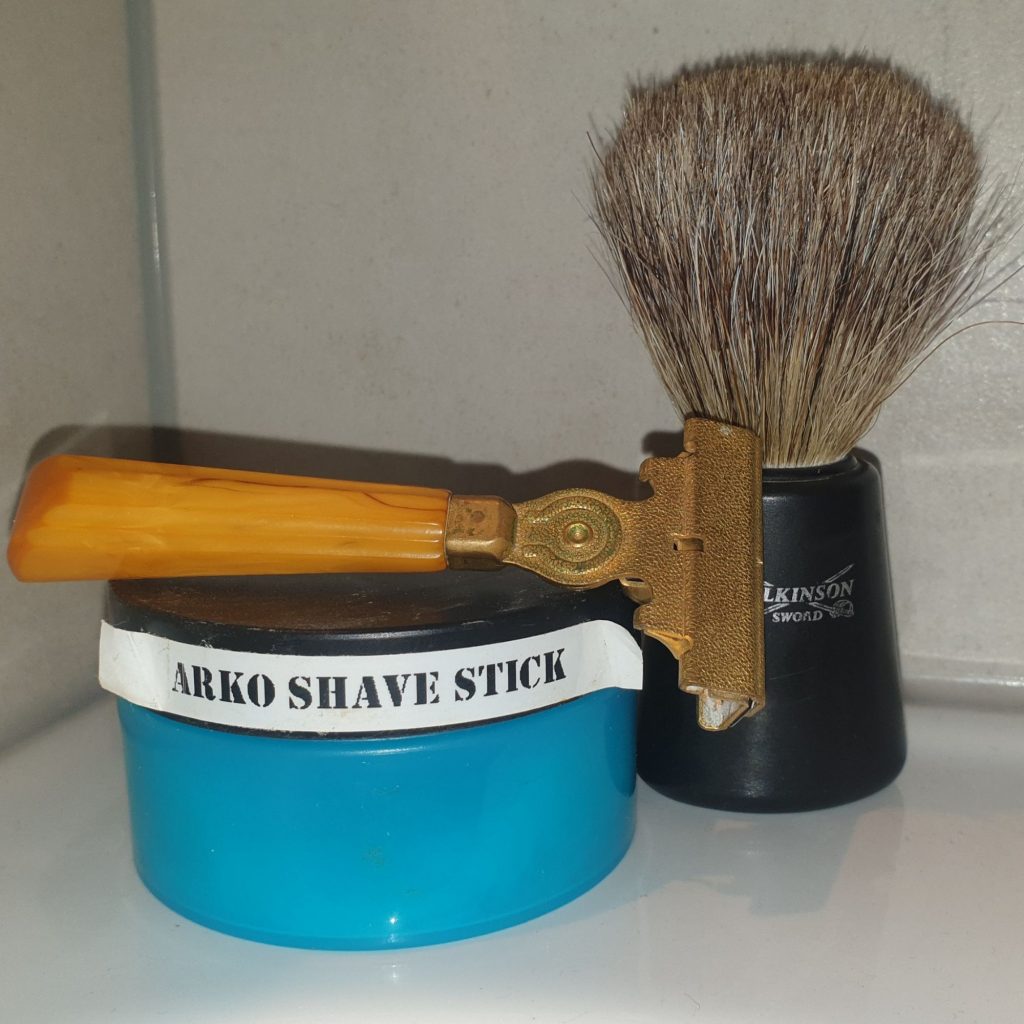
Another fantastic Friday shave. The last Schick shave for now, next week will be a GEM – unless the postman comes through with a package this weekend.
- Razor: Schick E2
- Blade: Personna Injector
- Brush: Semogue TSN LE 2012
- Pre-Shave: Proraso Pre Shave Cream
- Lather: B&M Latha Oceana
- Aftershave: Barber No3 Marmara
- Additional Care: Alum Block
A fine and fast Friday shave.
I am gettting a Autostrop VC1 in the mail any day now, so I will see what I find :P
History time: Instantly adjustable…
…in addition to being self-stropping. According to the advertisement, that is. Just how instantly adjustable it truly was is a different matter. I do suspect less so than the copywriter claimed.
Valet 1918 advertisement
>By a touch on the adjusting lug you can vary the distance between the blade and the guard with supreme precision and accuracy, according to the toughness of your beard or the tenderness of your skin.
From what I can tell, the “adjusting lug” they are talking about is the lever you use to release the blade for stropping. Which means that if you use it to lift the blade away from the guard, the blade is less well supported for the actual shaving.
And I might be less tough and more tender… but I do not want to shave with an unsupported blade.
As for what an instantly adjustable Valet would cost you.. .21 shilling is 1.05 pounds, also known as one Guinea (British pre-decimal currency was weird). and if we adjust for inflation, that would be 49.39£ (57.70€ / 61.89$ / 670.05 NOK) today. Not a cheap razor, but not terrible expensive either.
- Razor: Schick E2
- Blade: Personna Injector
- Brush: Brush Experimental Alpha
- Pre-Shave: Proraso Pre Shave Cream
- Lather: Body Shop Maco Root & Aloe
- Aftershave: Barber No3 Marmara
- Additional Care: Alum Block
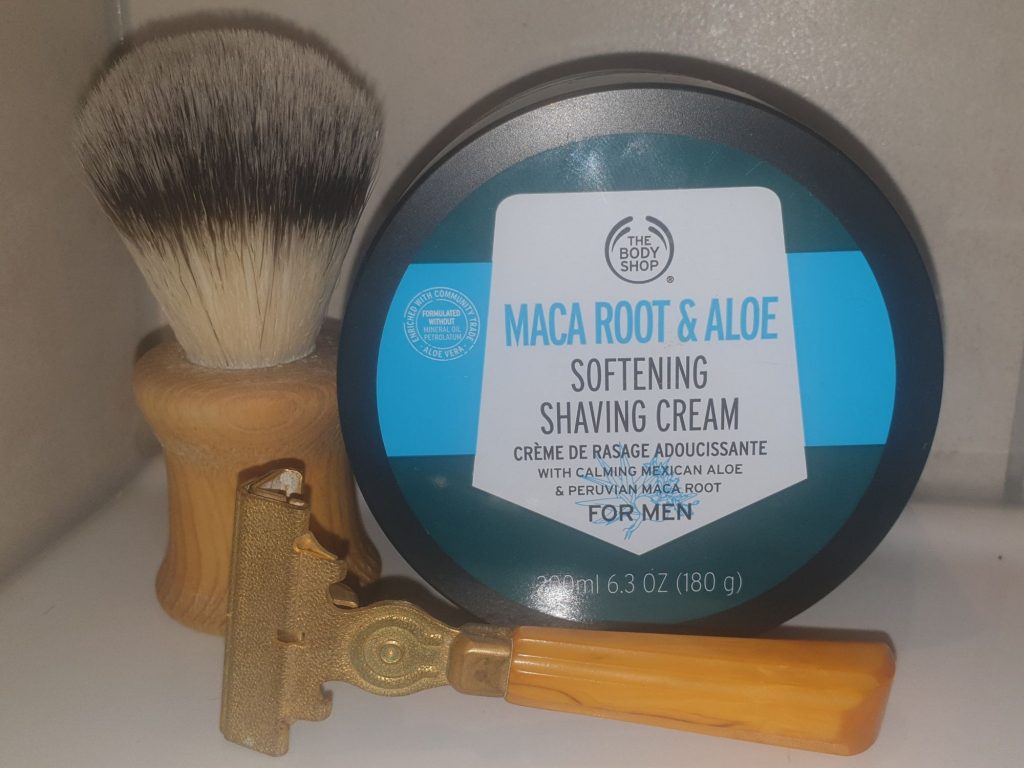
Another week, another shave – with an 83 year old razor. Who said things don’t last? All you have to do is to take care of them…
Patent time: Combined sales package and razor
Not only did Jacob Schick think up various repeating magazine razors – he also came up with the idea of a combined sales package and razor. Or, put another way, a razor blade dispenser with a built in razor. Or, arguably, a disposable razors that came with a supply of blades.
And the one I’ll discuss today isn’t even his first one… but the improved version.
Both versions of the combined sales package and razor aimed making a small and convenient blade package and razor that could fit in your vest pocket. Having looked at both, this version is smaller, handier, and requires less parts. Which is good when the whole point is to make it cheap. Or as the patent put’s it:
>This invention relates to an improved article which forms a shaving unit and consists of a combined blade package and razor, the blade package being in the form of a sales package so that the article can be supplied filled with blades and has an opening through which the blades can be fed, one at a time. It is preferably made so that it will be difficult to refill it all this in view of the fact that a large supply of blades can be furnished with the package and the whole device is so cheap that when the supply of blades is exhausted the article can be thrown away.
The whole thing takes the form of a small aluminium box, about as tall as it is wide. The blade looks to be about the size of an injector blade. If so the sales package and razor would be about 4 cm (1 6/10 inches) square, and about 1 cm ( 2/5 inches) thick. It’s partly a machined aluminium lump, and partly sheet metal cover.
Patent drawing from US patent 1,767,707
One half of the package was a blade dispenser. A slit in the end allowed the user to slide blades. And a pair of springs and a plate kept pressure on the stack of blades.
The other half of the combination package and razor is, unsurprisingly, the razor. A guard is machined into the metal body that makes up the box. The sheet metal cover forms the top cap and blade retainer. The guard and blade is covered with a, well, cover.
To change the blade, the user would press on the back of the combined sales package and razor. This would bend the sheet metal cover into an recess machined into the aluminium body, which would bend the top cap up. A quick shake would release the old blade. The old blade could then be user to push a new blade out enough for it to be pulled or pushed the rest of the way. Another push on the back would oven the cap again, so the new blade could be installed.
All in all it’s a handy little package. And while it might be a little more awkward to shave with than most razors, it would still make for a handy travel razor. Or a neat razor to keep in your vest pocket, so you can have a quick shave when you need one.
I can also see this being cast from a cheaper alloy like zamak, of even from injection moulded plastic. The only real drawback I see is the awkward shape. That, and the fact that the market today is overfilled with inexpensive disposable razors.
You can read the full patent for Jacob’s combined sales package and razor at Google Patents.
- Razor: Schick G4
- Blade: Personna Injector
- Brush: Artesania Romera Manchurian Badger, imitation horn
- Pre-Shave: Proraso Pre Shave Cream
- Lather: Asylum Shave Works Colonia
- Aftershave: Saponificio Varesino Tundra Artica
- Additional Care: Alum Block
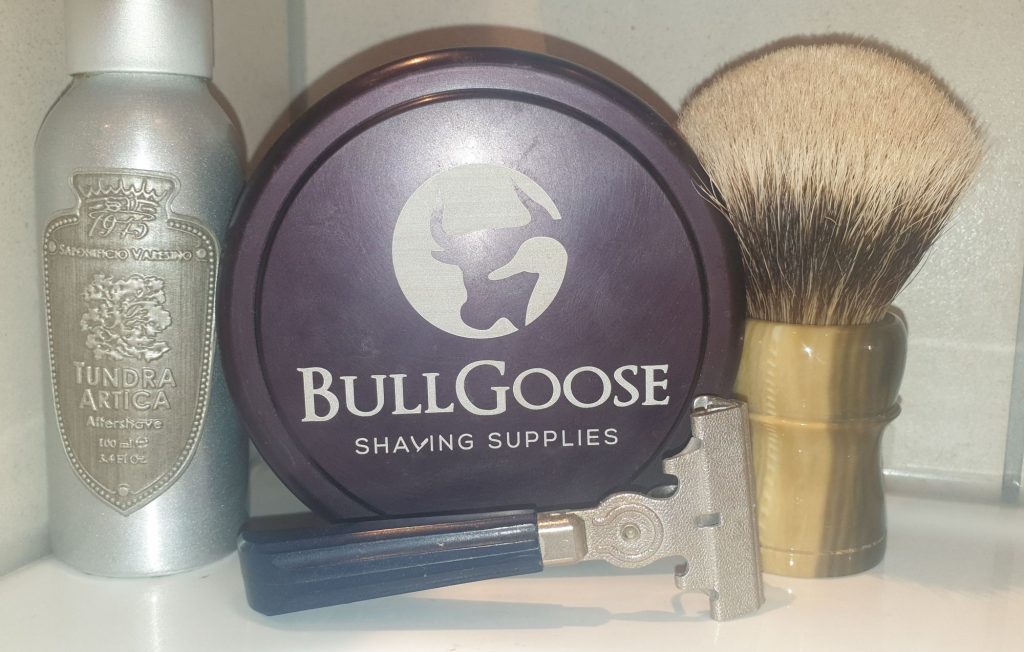
Another wonderful Wednesday shave.
The brush, soap, and soap holder all came from Phil’s shop some years ago, while the razor was from the ‘Nook’s BST.
Patent time: Schick’s second repeating razor
Schick didn’t go directly from his first patent to the Type A. In between he patented a second repeating razor, that has a fair bit in common with the first patent.
Unlike the first patent, the second patent specifically mentions the use of a blade package. It extols the virtue of the package as a sanitary improvement. To quote:
>The holder and the stack of blades in it form a unit that can be inserted into the razor without the user handling an individual blade either to in sort it in the holder or to place it in shaving position. The holder and the blades form an expendable unit so that the purchaser simply inserts the filled holder into the razor and after the blades are used up the holder is thrown away. This not only provides for economy in manufacture and saves time in using the razor, but it also guards against injury as the user need not handle an individual blade at any time.
>Furthermore, this package insures a sanitary razor as when the packing of blades in a holder is done automatically the individual blades need not be handled by anyone from the time they are packed until they are used for shaving.
Conceptually there is not that much difference between Jacob’s first and second repeating razor. On both you manipulated part of the razor to make the top cap move back and forth.
But the devil is in the details, as always.
Patent drawing from US patent 1,584,811
Instead of twisting the handle back and forth, on the second patent you twisted the knob at the bottom. This moved – through a cam and a bell crank – the top plate back far enough that it would pick up a blade from the magazine. Twisting the knob further would cause the top plate would swing forward, ejecting the old blade and presenting a new one for use.
Or as the patent text puts it:
>The means shown for operating the top plate consists of an arm 17 which is pivoted on a pin 18, this pivotal point being the center of the radius of the opposed faces of the top plate and the guard. The arm has an extension 19 which fits in a slot 20 in a collar 21 thus forming a cam on the end of the stem 22 the projecting end 23 of which is beyond the end of the handle and thus available for easy manipulation.
>It will be seen from this that when the finger piece 23 is turned the cam groove 20 will actuate the finger 19 and this in turn swings the arm 17 which being secured to the top plate moves the top plate to the desired position. Suitable insignia can be placed on the finger piece or handle to indicate relative positions and directions of operation for placing the blade.
There are three major improvements, as I see them, in Jacob’s second repeating razor.
Firstly, the mechanism is a fair bit neater. Gone are the rack and spur gears, replaced by a cam and a bell crank. The back and forth motion is replaced by a full rotation of the knob.
Secondly, the blades are kept in a carrier. This means that the shaver won’t have to manipulate a stack of thin, razor sharp razor blades.
And thirdly, it just looks better.
The downsides are much the same as in the first patent. The head don’t fold, meaning it is less suitable as a travel razor. And the blade magazine is right up by the wet end… which could cause carbon blades to rust. With modern stainless blades, the risk of corrosion is much reduced.
My only concern is that the short end of the bell crank that rides in the cam track looks a bit flimsy. Apart from that, I would buy this razor if someone manufactured it today.
You can read the full patent for Jacob’s second repeating razor at Google Patents.
- Razor: Schick G4
- Blade: Personna Injector
- Brush: Wilkinson Sword Badger
- Pre-Shave: Proraso Pre Shave Cream
- Aftershave: Barber No3 Marmara
- Additional Care: Alum Block
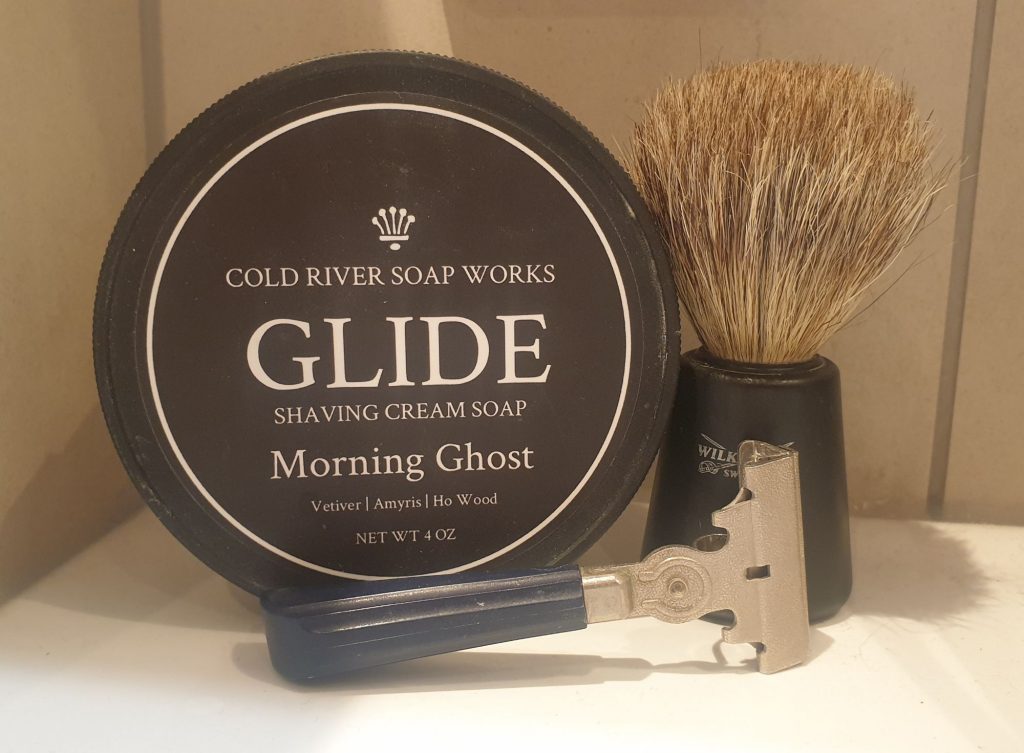
A fun and fast midweek shave.
Patent time: The original Schick Repeating Razor
We all know that the Type A was the first Magazine Repeating Razor. But nothing gets created in a vacuum, and Jacob Schick filed a patent for his first repeating razor as early as 1921. And while it could hold a blade pack in the handle as the later types A through C, the main magazine was in the razor’s head.
As I’ve said over and over again, an invention is an attempt to solve a problem. And reading Jacob’s patent, it is clear that his repeating razor was aimed at simplifying the act of changing blades. To quote:
>This invention relates to an improved safety razor which is adapted to use what are commonly known as wafer blades, that is, thin blades, these blades being held within the razor and adapted to be fed therefrom into shaving position when desired, and can be pushed beyond the shaving position for ejection or either to be replaced by a new blade or for the purpose of washing the blade and the razor.
The idea was both simpler and more complex than the later Magazine Repeating Razors. Unlike the later, the head didn’t need to rotate through 90° to be reloaded. On the other hand, the relatively simple plunger hadn't come into existence yet. Instead the top plate of the head was made to pivot, controlled by the twisting of the handle.
Patent drawing from US patent 1,452,935
As can be seen from the drawing, the handle can rotate in relation to the neck and head. A spur gear is secured to the stem the handle rotates around. This spur gear interacts with a rack that connects to the top plate with a pair of lever arms.
Twist the handle in one direction, the used blade is ejected. Twist it in the opposite direction, an edge on the underside of the top plate picks up a new blade. Return the handle to the centre, and you’re good to shave.
It’s a fairly simple system, and it has both good points and bad points compared to the later Magazine Repeating Razors.
On the plus side, there is no blade carrier as you’ll find on the later repeating razors. No carrier means you can’t insert it the wrong way… which incidentally means that you’ll jam up the inner workings. And you can keep a spare pack of blades in the hollow handle.
As for the negatives? Well, the razor head don’t fold, meaning this repeating razor is less well suited for travel. The blade stack is kept close to the actual shave, so you’ll risk corrosion. And unless there is a detent, there is the chance of the handle twisting as you shave.
I can see why Jacob didn’t put this repeating razor into production. The later magazine repeaters are both more convenient with their folding heads, and there was less risk of carbon steel blades rusting. At the same time I can see this razor doing okay today, with stainless steel blades and less focus on portability.
You can read the full patent text for Jacob Schick’s first repeating razor at Google Patents.
History time: We menfolk don’t like to buy “cheap”…
…at least if the old ad for the Bessegg blade is to be believed. Speaking as one of the menfolk, I’m inclined to agree.
I’ve talked about Bessegg before – covering both the blades and two ads for their razor. Today we have a blade advertisement, which according to the source is from 1935. The Bessegg factory operated from 1927 until 1961, so bare minimum the advertisement cannot be older or newer than that.
The Bessegg ad – talking to the menfolk
A quick translation;
>We menfolk don’t like to buy “cheap”. We want something good – something first class – BESSEGG > >BESSEGG BLADE > >“The new quality” – 25 øre per blade – Norwegian and good
Cheap, in context, don’t mean inexpensive. It means something cheaply or shoddily made. And as one of the menfolk, I can attest that I don’t want a cheap blade in my razor – but I’m more than happy to buy inexpensive blades if they are good.
For context, 25 øre in 1935 is 16 kroner and 23 øre today – or 1.52 USD / 1.40 EUR / 1.20 GBP.
Per blade.
So not cheap in the more vernacular meaning of the word either.